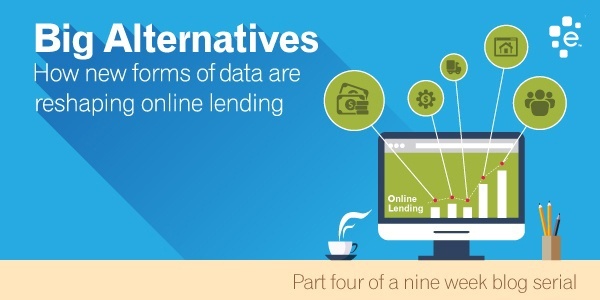
Online lenders represent a valuable resource for small businesses in need of working capital. Also known as “alternative” lenders, they are particularly useful to new businesses lacking the long, detailed credit history that banks and traditional lenders usually require to underwrite a commercial loan.
This is why online lenders have become so popular with newer restaurants, small retailers, young business service companies and other enterprises that have no other place to go for working capital. Being unregulated, online lenders can be far more lenient with their lending requirements.
However, online lenders don’t lend blindly. They don’t base their decisions on a catchy name and an inspiring mission statement. Online lenders have numerous sources of data upon which to base their decisions; as you might imagine, many of these sources are as “non-traditional” as the lenders themselves.
For example, there are many names people use to describe the new types of data online lenders use to qualify applicants, such as “Big Data,” “alternative data” and “online data.” Essentially, they all mean the same thing: Readily available information that can be used to determine a business’ financial health above and beyond traditional credit scores.
New Data Sources for Online Lenders
In addition to checking accounts and tax returns, online lenders may use any number of alternative sources of data to evaluate potential borrowers, including:
- Social Media. What customers say about a business on various social sites offer more important clues as to a business’ health. A business with high ratings from a large number of customers may be a good risk, even if it’s only been in business for one or two years.
- Online Financial Activity. Heavy activity on sites like PayPal or Ebay can suggest a healthy cash flow, something that’s important to many online lenders. Permissioned access to business checking account information also allows lenders to better assess cash flow.
- Accounting Software. Having direct access to a borrower’s accounting software (e.g. QuickBooks, FreshBooks) allows a potential lender to observe and track a borrower’s financial activity in real time. Such data can also provide a lender with an early warning signal should the borrower suddenly get into trouble.
- Shipping Data. If a borrower is a retailer, whether B2B or B2C, are its products moving? Shipping data — both volume and frequency — is another valuable indicator of financial stability.
Privacy & Security Issues
How do online lenders capture this data, particularly the proprietary information not readily available through a Google search or social media? They get it straight from the borrower.
When a business owner agrees to an online loan, they’re often agreeing to provide the lender direct access to their business checking, accounting and management system. And sometimes not just for a one-time look, either. This may involve long-term access so the lender can keep an eye on its investment. The downside to this arrangement is, of course, privacy and security vulnerabilities. The upside is that it may help expedite future borrowing.
Interpretation is Critical
Of course, data by itself does not tell the whole story; it must be properly interpreted. This is particularly true of alternative data.
For example, the ratings a restaurant receives on social media can’t be judged against ratings for a dry cleaner. A restaurant in any city is likely to get far more social media coverage than is a neighborhood dry cleaner. However, a dry cleaner with just two or three reviews may be a far better business risk than a restaurant with 10. It’s all about being able to interpret, normalize and glean insights from the data you collect.
Packaging Online Data for Risk Assessment
Five years ago, Experian created its Global Data Laboratory in San Diego for the express purpose of mining alternative data and seeing if it could be packaged as a commercial product to help online lenders and other companies evaluate new, small companies. Staffed with a team of Ph.D.’s in data science, the lab has built a one thousand (1,000) terabyte database containing information from thousands of sources.
 “One of the big challenges any lender faces is determining if a borrower is legitimate. This is true even for traditional businesses, like a Home Depot that may want to open a credit line with a small contractor that has little or no credit history. For every 100 companies that are ‘invisible’ to lenders, we can now establish the legitimacy of 20 businesses using nothing but online sources. That means a business can now have as much as 20 percent more customers than before just by accessing this alternative data. The lab’s new algorithms are also highly predictive of a company’s longevity.”
“One of the big challenges any lender faces is determining if a borrower is legitimate. This is true even for traditional businesses, like a Home Depot that may want to open a credit line with a small contractor that has little or no credit history. For every 100 companies that are ‘invisible’ to lenders, we can now establish the legitimacy of 20 businesses using nothing but online sources. That means a business can now have as much as 20 percent more customers than before just by accessing this alternative data. The lab’s new algorithms are also highly predictive of a company’s longevity.”
Eric Haller
EVP Experian Data Labs
For new and emerging businesses, leveraging data from the Web can deliver a 40 percent lift in predictive performance compared to the industry averages for predicting whether a company will go out of business or not.
Just Part of the Equation
As useful as alternative data is, it’s just part of the algorithm an online lender uses to score borrowers. Traditional credit scores are usually still part of the evaluation process. When available, nothing predicts credit risk better than credit history.
Even the most sophisticated online lenders are still going to look at trade experience, business registrations and other third-party information. Alternative data sources become just one part of the equation.
New sources of customer information and readily available online data, combined with traditional data and metrics – and the experience necessary to properly interpret both – has created a robust online financial marketplace and gives small business owners unparalleled access, flexibility and choice when it comes to capital financing.
While it’s still a bit like the Wild West, the world of online lending continues to grow robustly. Through the use of Big Data, Experian is able to provide insights that help minimize risks for borrowers and lenders alike. That helps everyone.
Related articles
Just how alternative are today’s online marketplace lenders?
How online marketplace lenders are changing the rules of small-business finance
Self-Regulatory Program for Nonbank Small Business Lenders
Top regulatory priorities for commercial lenders
Playing to Your Strength – Opportunities for Regional Banks to Build Better Lending Portfolios
Game Changer – How Marketplace Platforms Are Bringing Financial Institutions Back to Small-Business Lending
Marketplace Matchmakers – How Loan Aggregators Bring Borrowers and Lenders Together
New Frontiers – What’s Next For Marketplace Lending?
